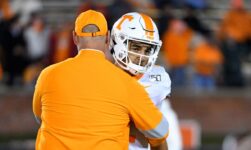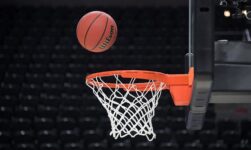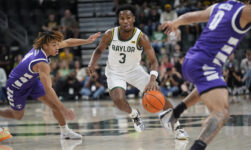Illinois basketball is poised to have its best season in more than a decade. The 21st-ranked Illini won by 17 at Purdue on Tuesday night to move to 14-5 with a 6-2 Big Ten record.
This is the team’s best overall start through 19 games since 2012-13. It’s Illinois’ best start in league play since 2005-06. It’s happening because 56-year-old Brad Underwood drastically changed his approach to coaching in the offseason, upgrading his strategy, altering identity — and fast-tracking Illinois to its first NCAA Tournament in seven years in the process.
From 2013-16, Underwood was immediately incredible at Stephen F. Austin, winning 89 games in his first three seasons (tying Brad Stevens for most wins to start a career in that span in NCAA history) and making three straight NCAA Tournaments. He bumped up to Oklahoma State in 2016 and took the Cowboys to the NCAAs with the No. 1-rated offense in his first season.
Illinois lured him away in 2017 and Underwood landed where he thought he could spend a decade-plus and finish his career. But the first two seasons were arduous. Illinois went 26-39. The man opted for drastic refining. He brought in young, talented analytical minds from the NBA to help him compare his Illinois teams’ statistical trends against Sweet 16 teams in recent seasons and against high-level Big Ten squads. The gaps were glaring.
His team’s lack of free-throw attempts combined with its penchant for fouling was startling. Underwood and his staff also diagnosed offensive rebounding, turnovers and 3-point shooting as key components. They examined the impact those stats had on games and where Illinois faltered those categories. Underwood’s desire for rabid ball pressure had to be sacrificed. There would be no wending: alterations would be resolute and close to exact.
It’s all kind of a mosh pit of change. You can’t shortcut it.Brad Underwood
“We knew from that we had to make changes defensively, even though we were turning people over at an extremely high rate,” Underwood told me. “Second in the country, but on the back end it wasn’t worth it. We were fouling too much, were starting almost every game down eight points at the foul line. We were not maximizing with free throw attempts for us or picking up offensive rebounds for extra possessions. We felt that combination was too difficult to achieve at the highest level, to balance it out. That forced changes.”
Illinois is 10th in free-throw rate this season. It was 338th last season. It’s No. 4 in offensive rebound percentage after checking in at 148 in 2018-19. This is, by far, the best interior defensive team of Underwood’s career (45.1% 2-point defense). Other tweaks have helped. Freshman Kofi Cockburn has been tremendous on the glass. Underwood put the ball back in Trent Frazier’s hands — and he’s had only four turnovers in 10 games. Ayo Dosunmu has since thrived off the ball.
“It’s all kind of a mosh pit of change and growth and stuff that had to happen in the process of getting to this point,” Underwood told me Tuesday. “You can’t shortcut it.”
Tuesday vs. Purdue, Illinois scored nearly 1.3 points per possession — its best performance under Underwood in league play yet. The Illini won at Purdue for the first time in a dozen years after previously winning at Wisconsin for the first time in a decade. It’s all coming together.
Six weeks ago, Underwood wasn’t convinced it would. Illinois started this season 5-3 vs. D-I competition. He privately questioned the makeover. But two of the losses came by three total points.
“I think there was some struggles early and there was doubt simply because it was new to me and it challenged my patience early, just from the standpoint that I knew if we played certain opponents that we would win easily had we played the old way,” Underwood said. “This was more methodical and more about the long haul and more about the course of time. It would always work itself out. And instead of beating somebody by 30, it’s a 15- or 16-point win. That was something I had to look at or something a team has a certain weakness at the point guard spot, well our pressure previously would eat that up. That’s not necessarily going to be the case now. Scouting has become very, very impactful — not that it wasn’t so before — but the scheming part of it and the game-planning for your players and the way we teach it has changed as well, so it’s been all-around impactful change but it’s been very helpful for players for the most part and not maybe as stressful as playing the other way was.”
Underwood had to give up wanting to force teams into fast possessions and then try to score quick or drain clock. Really, he gave up control of his team in a lot of ways, which is something most coaches cannot part with. And the biggest test would be if this new ideology could turn the trick in the best league in college basketball.
“I was not sure in the Big Ten if it translated to road wins,” he said. “If playing high-pressure and the fouls, I didn’t know if that translated to winning on the road. … To this point it’s really translated well and everything I’ve been trying to establish this program has been trying to find a way to win when the ball doesn’t go in. At the end of the day, that’s what this was all about.”
Illinois is 22nd at KenPom, it’s highest ranking in nine years. Coaches often look to evolve, but few throw out most of the playbook. Underwood changed his stripes and Illinois is finally relevant — and NCAA Tournament-bound — because of it.
Markus Howard is somehow underappreciatedMarkus Howard has become a savant at making a 40-burger.
USATSI
On Saturday, Markus Howard cracked 40 points for the third time this season, dropping 42 on Georgetown and lifting Marquette to an 84-80 road W. Howard comfortably leads the nation in scoring (his 28.4-point average outpacing UTSA’s Jhivvan Jackson at 25.8). Incredibly, Howard’s clipped 40 seven times in his marvelous career. The senior sniper is in rare company. Thanks to the crack research team at CBS, I can share this surprising nugget: there are only four players who have had at least seven 40-point college games the past 24 seasons. It’s Howard and:
Keydren Clark, Saint Peter’s: 8 (2003-06)Marcus Keene, Central Michigan: 7 (2016-17)Charles Jones, LIU: 7 (1996-98)
Keene played at Youngstown State and Central Michigan, but remarkably all of his seven of his 40-pointers were in his lone season at Central Michigan (he might be the only guy since LSU’s Pete Maravich to have at least seven 40-point games in a season). What’s more, 26 men’s D-I players have gone for 40 at least three times in a season since 1994, but Howard and Jones are the only ones to get at least three in consecutive years.
And among Big East programs (incoming UConn included), Marquette and Providence are the only schools with players to go for 40 at least seven times in school history. (Providence’s Providence’s Jimmy Walker went for the ocho way back in the 1960s.) At 4.24 made 3-pointers per game, Howard ranks third nationally in that category and has to be on the short list for National Player of the Year. A scoring savant, yet somehow still undervalued.
Historic week for Rutgers and the AP poll
This week’s AP Top 25 was significant for many reasons. You had the rare instance of a No. 1 team — on the heels of two dominant wins — nonetheless losing its spot and getting leapfrogged. That’s what happened when Baylor jumped over Gonzaga, becoming the seventh No. 1 team this season. Seven matches 1982-83’s record. One more and, in terms of top ranking, we will officially have the most chaotic regular season in college basketball history. There were also sizable droughts that ended. Courtesy of the ever-reliable College Poll Archive:
Dayton top-10 for first time since Dec. 4, 1967 (935 poll weeks)Florida State top-five for first time since Dec. 11, 1972 (856 weeks)Seton Hall top-10 for first time since Dec. 18, 2000 (368 weeks)
But the biggest headline to come out of the Monday refresh was the royal return of Rutgers (14-4, 5-2). The Scarlet Knights went almost 41 years between appearances, having last made it in the final poll of the 1978-79 season.
That’s a 738-week hiatus, making RU the team with the longest drought between appearances of any power-conference school ever. Butler going 53 years (1949-2002) is longer but BU was a mid-major through and through for that run. Now the longest power-conference drought is with Oregon State. The Beavers are at 538 weeks without being ranked, dating back to 1990.
Rutgers is 13-0 at home, its best start ever. It hasn’t been three games above .500 in conference play in 21 seasons. It plays at Iowa on Wednesday.
Stunning odds behind Vandy’s o-fer from 3-point range
Vanderbilt earned notoriety over the weekend for snapping its 1,080-game streak of making a 3-pointer in a loss to Tennessee. It did this in historic, flameout fashion. Vandy was 0 for 25 from beyond the arc, an NCAA record for most 3-point attempts in a game without one make. It got me thinking: How statistically unlikely is it that a team making 37.3% of its 3-pointers would not make even one out of 25 heaves?
I courted the help of John Ezekowitz, who’s a Harvard grad, basketball stat whiz and a man who’s done data consulting for an NBA franchise.
“To roughly calculate the odds of Vanderbilt missing all 25 3-pointers they took, we make the simplifying assumption that each of those 3s was independent (i.e., the outcome did not depend on the other shots),” Ezekowitz wrote. “This is probably not completely accurate because it discounts factors like a cold hand or Tennessee’s defensive strategy, but it should be close enough. Vanderbilt came into the Tennessee game shooting 37.3% from 3 for the year (128 of 401), but were without the injured Aaron Nesmith. Nesmith had shot an amazing 60-of-115 for the year; removing him from the Dores’ shooting results shows a very poor shooting team. The other Vandy players were a combined 23.8%. If we treat all shots as independent, we can calculate the probability of Vandy going 0 for 25 by taking the probability of a miss (1 – 23.8%, or 76.2%) to the 25th power. This is the equivalent of flipping a coin 25 times and landing on tails each time, except the probability of landing tails is 76.2%. This calculation yields a probability of 0.11%, or 1 in 884.”
Nesmith, an NBA prospect, is out with a stress fracture. He made 47% of Vanderbilt’s 3-pointers prior to the UT game. (And, well, after it.)
Ezekowitz also said if Nesmith had been able to play in the game, the chances would have dropped from 1 in 884 to 1 in 11,000. Wild! To put in other terms: it’s statistically more likely to get two No. 16 seeds beating a 1 in the same NCAA Tournament (closer to 1 in 100) than to have a team — even a poor-shooting team — take 25 3-pointers and not make one.
@ me
Have a question, curiosity or complaint? Do @ me. Lob your questions my way on Twitter.
“Less than mediocre” is maybe a little too thick. He’s made two NCAA Tournaments in four previous seasons and isn’t for sure out of making it in 2020. I know it’s not recruiting. Texas has produced three first-round draft picks under Shaka Smart: Jarrett Allen, Mohamed Bamba, Jaxson Hayes, but beyond those guys, since Smart arrived, Texas’ classes have ranked No. 6 (2016), No. 6 (2017), No. 8 (2018), No. 17 (2019). I think losing Hayes and Allen ahead of schedule actually had some consequences in terms of how Smart wanted to build his roster. No way he expected Hayes to be a one-and-done. Combine that with some bad luck in terms of availability in the backcourt (which has led to a dip in shooting and 3-point defense) and that’s a broad stroke at why it’s been bumpy.
Love a good research question! NCAA Tournament seeding has existed in its proper form since 1979. We’ve never had a tournament that had all four No. 1 seeds based west of the Mississippi River. The closest we came geographically was 2003, when Arizona, Oklahoma, Texas and … Kentucky got there. But right now? Yeah: Baylor, Gonzaga, San Diego State and Kansas would be the 1 seeds if we bracketed today. Good thing to track in the coming weeks. It’s going to have to be those four, though. Teams right behind ’em are all east of the big river: Florida State, Duke, West Virginia, Butler, Michigan State, Dayton, Louisville, Seton Hall, Villanova.
Gonzaga’s home arena (McCarthey Athletic Center) is not the same venue that would host first-weekend tourney games (Spokane Veterans Memorial Arena) this March. Schools are allowed three total “home” games at secondary venues to qualify to play in those arenas, and the schools themselves cannot host. Idaho is the host for Spokane’s pod, and Gonzaga has no games scheduled for Spokane Veterans Memorial Arena. The Zags are a lock to play in Spokane this year.
Au contraire, mon frère. The 19-1 Flames are up at No. 25 in the NET and would be a guarantee at-large team (in this wild season) if they lost two or three games total and were sitting at, say, 27-3 vs. D-I teams on Selection Sunday.
Final shots I don’t know how many times this has ever happened in Division I, but I’m going to be so invested on Feb. 24, when Gardner-Webb and Hampton will RESUME THEIR GAME FROM MONDAY NIGHT. It had to be halted due to “a permanent mechanical malfunction of one shot clock. … All stats and fouls will remain the same as when the game was halted.” Gardner-Webb holds an eight-point lead (39-31) for what might be the longest halftime in men’s hoops history: it will last approximately 840 hours and be witness to 20 combined games between Gardner-Webb and Hampton before this one is scheduled to carry on. If I’m a reporter covering that Feb. 24 game, the very first question I’m asking to the winning side is, “Coach, what adjustments did you make at halftime?”How stacked is the Big Ten? As of Tuesday night, 12 of the league’s 14 teams were in the top 50 of the NET. That’s double the number of the next-closest conference (the Pac-12 with six). We’re inching closer to the reality that the Big Ten will send 10 to the NCAAs.Shouts to Eastern Illinois guard Mack Smith, who’s made a 3-pointer in 67 straight games, the longest streak going in D-I. It’s also the third-longest streak in men’s D-I history. The only longer streaks are Illinois’ Cory Bradford (88, ended in 2001) and Virginia Tech’s Wally Lancaster (73, ended in 1989). Weird: Missouri, between two games, made an NCAA-record 51 straight foul shots vs. Alabama and Texas A&M … and lost both games. Great new for Louisville: Chris Mack told reporters that freshman guard David Johnson is good to play Wednesday night vs. Georgia Tech. Johnson had a quick shoulder scare (he had surgery on his labrum in 2019) after being Louisville’s best player in its win at Duke on Saturday. Johnson might be the key to clinching Louisville’s credentials as a title contender.For the crowd who thinks college basketball’s set to lose out on even more stars: Freshman-to-be Jalen Green shut down the overseas rumors this week. He’ll be in D-I next year, either at Auburn or Memphis.
Source link




